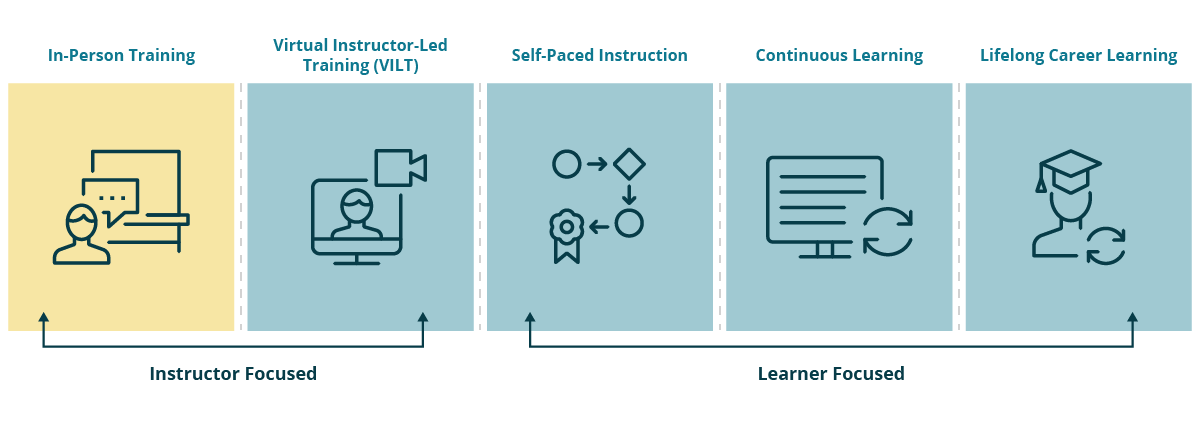Digital Transformation of Learning Series: Part 1 - Creating a Strategy
The events of 2020 have shown us that having a plan for the digital transformation of your learning business is more important than ever. As we already have seen, many organizations are quickly shifting resources to provide training and certification digitally to maintain business and revenue continuity.
This two-part blog series will cover the strategy behind implementing a plan for digital transformation, as well as some tips on building a digital learning platform that enables users to conduct self-paced learning. First, we will take a dive into the strategy.
What’s next for in-person training?
For organizations that rely on in-person, instructor-led training, now is the perfect time to step back and develop a digital transformation strategy. While the obvious solution is to simply shift from in-person to virtual training, there is an opportunity to take the transformation a step further and build a multi-faceted, technology-enabled delivery model that enables self-paced and continuous learning for your students.
Why? Because in the digital world, self-paced training is one of the best ways to achieve your ultimate goal: better learner outcomes. When learners are free to work through educational content on their own time and at their own pace, learning becomes more convenient and motivation is increased. As a provider, you get to offer additional flexibility, avoid scheduling issues, and increase the cost effectiveness of your program.
The learning use case spectrum
If we think about the different learning use cases, we can place them on a spectrum from in-person, instructor-led training through lifelong professional learning and development. Each of these use cases has its own technology requirements and aren’t necessarily mutually exclusive - education and professional training providers often employ more than one at the same time.

For example, you may provide self-paced learning prior to an online workshop with an instructor in order to introduce learners to topics. You might also follow up with a continuous learning solution such as a microlearning application that will periodically quiz the learner on a single topic in order to help them retain the acquired knowledge. Having a plan for moving along this spectrum is important because as the learning delivery use cases move from left to right, the length of the learning engagement between the learner and the training service provider increases.
Let’s take a look at each of these learning use cases individually:
In-Person Training
In-person training is familiar to all of us - we’ve been in a classroom to receive instruction, from our early childhood to adult years, at some point during our lives. The training is set in a physical room, in real time, with peers and an instructor. The focal point for the training is the instructor. It’s a one-to-many situation, with the instructor setting the pace of lessons and the timed execution of assessments or tests for the learners.
Virtual Instructor-Led Training (VILT)
Virtual instructor-led training refers to training that is delivered in a virtual environment. The instructor and learners are usually not in the same room. The virtual class happens online, and learners access the class by using a computer, tablet, or smartphone. Learners can download course materials but the instructor still leads the pace of lessons and assessments, as with in-person training.
Self-Paced Instruction
Self-paced instruction is dictated by the learner. The content itself can be personalized, part of a curriculum, corporate training, technical tutorials, or microlearning. The content could also consist of different learning modalities like lessons, flashcards, study plans, practice questions, or games. Learners engage with the content as needed in order to prepare themselves for an upcoming skills assessment or credentialing exam. Learners can engage with the study materials on their own schedule - they aren’t beholden to a scheduled class and they are free to spend as much time learning as they need.
Continuous Learning
Continuous learning focuses on delivering small chunks of learning over short periods of time. A good example of continuous learning is the repeated daily delivery of questions to a learner who is focused on improving their assessed weaknesses. Learners can engage with continuous learning content alongside self-paced instruction or after they complete a course. This helps them combat the forgetting curve and practice skills to boost retention.
Lifelong Career Learning
Lifelong career learning is a broad combination and synthesis of the previously introduced learning delivery use cases. Lesson introduction can be based on an assessment, desired career skills and certifications, work tenure, experience, or long-term career goals.
Lifelong career learning modalities exist in the LMS, within the company enterprise, and on the internet. In the end, however, the goal remains the same for education and training service providers: to provide verified educational and training services that allow for professional advancement for their customers and speak to their level of proficiency in their chosen craft.
How to progress along the spectrum
From one end of the spectrum to the other, the progressive pathway along a digital journey shifts the focus from the instructor to the learner. The learner experience becomes paramount in order to successfully prepare for skills assessments, credentialing exams, and knowledge sustainability.
So what are the essential strategic steps to take to begin this journey?
- Assess your current delivery model - Education and training service providers must take an assessment of their current in-person training before setting off to move to a digital delivery model. The identification of courses to digitally convert is an absolute must in order to properly scope the project.
- Identify your business objectives – These objectives will be your north star – guiding your digital transformation and the decisions you will make during the conversion process, such as the selection of a digital learning platform that’s suited for your business. If a quick conversion to a digital learning experience is needed for business continuity, then quickly move to a VILT lite solution.
- Select an experienced learning platform provider – Your selected vendor should be able to help you with your transition to a digital learning platform. You will want to select one that has not only the LMS features you will need, but also the services and support necessary for you to successfully transition and operate your learning business. The vendor should have implementation, learning and design services, and customer support and customer success teams to augment your internal resources.
Once you have decided on your strategy, the next step is to execute. In the next blog post in this series, we will cover some tips on transitioning to a digital learning platform that enables self-paced learning.
BenchPrep offers a wide variety of digital learning options, including the BenchPrep Engage microlearning platform. Check out this e-book if you’re interested in learning more about how continuous learning can lead to additional revenue for your learning organization.
In part one of this blog series, we covered the strategy for implementing your digital transformation plan. Within part two of this blog series, we will cover some tactics and tips for executing on the digital transformation strategy.






